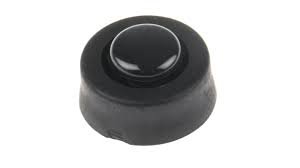Round Anti-Vibration Feet: The Solution to Noisy and Wobbly Equipment
Round anti-vibration feet are typically used to reduce vibrations and noise in equipment and machinery. These feet can be made from materials such as rubber, neoprene, silicone or polyurethane, which absorb vibrations and reduce their transmission to the floor. Anti-vibration feet can be used in a variety of applications, including machinery, electronics, scientific equipment, and more. They can be attached to the bottom of the equipment using screws, adhesives, or other methods. The round shape of the feet allows for greater surface area contact with the floor, providing more stability and reducing the chance of equipment tipping over.

How do Round Anti-Vibration Feet work?
Round anti-vibration feet work by absorbing and damping vibrations that are generated by equipment and machinery, preventing them from being transmitted to the floor. The feet are typically made from materials that have good shock-absorbing properties, such as rubber, neoprene, silicone, or polyurethane.
When equipment vibrates, the anti-vibration feet compress slightly, absorbing some of the energy from the vibrations. The material used in the feet then returns to its original shape, releasing the energy as heat, thus reducing the overall level of vibration transmitted to the floor. The round shape of the feet also provides a larger surface area in contact with the floor, which helps to distribute the weight of the equipment more evenly and reduces the risk of equipment tipping over.
In addition to reducing noise, round anti-vibration feet can also extend the life of equipment by reducing the stress on components caused by repeated vibrations. This is especially important for sensitive equipment, such as precision scientific instruments, that are particularly susceptible to damage from vibrations.

Advantages
There are several advantages to using round anti-vibration feet:
- Reduced Noise: Round anti-vibration feet can significantly reduce the noise generated by vibrating equipment, making work environments more pleasant and productive.
- Increased Stability: By distributing the weight of the equipment more evenly, round anti-vibration feet can improve stability and reduce the risk of equipment tipping over.
- Extended Equipment Life: By reducing the stress on components caused by repeated vibrations, round anti-vibration feet can extend the life of equipment, especially sensitive equipment such as scientific instruments.
- Improved Equipment Performance: Vibrations can negatively impact the performance of equipment, leading to inaccurate results or malfunction. By reducing vibrations, round anti-vibration feet can help to improve the performance of equipment.
- Ease of Installation: Round anti-vibration feet are typically easy to install and can be attached to the bottom of equipment using screws, adhesives, or other methods.
- Cost-effective: Compared to other solutions for reducing vibrations and noise, round anti-vibration feet can be a cost-effective solution for improving equipment performance and longevity.
- Versatility: Round anti-vibration feet can be used in a variety of applications, including machinery, electronics, scientific equipment, and more.
Materials Used to Make Round Anti-Vibration Feet
Round anti-vibration feet can be made from a variety of materials, including:
- Rubber: Rubber is a popular material for making round anti-vibration feet because of its good shock-absorbing properties. It is durable, flexible, and has good resistance to heat, chemicals, and ozone.
- Neoprene: Neoprene is a synthetic rubber that is also commonly used for making round anti-vibration feet. It is similar to natural rubber in terms of its properties and performance but is more resistant to oil, ozone, and weathering.
- Silicone: Silicone is a synthetic material that is widely used in the manufacture of round anti-vibration feet due to its durability, high-temperature resistance, and good shock-absorbing properties.
- Polyurethane: Polyurethane is a versatile polymer that can be formulated to provide a wide range of properties, including good shock absorption, high resilience, and good chemical resistance. It is also resistant to abrasion and can be formulated to have a good memory, meaning that it will return to its original shape after being compressed.

Proper Installation
Proper installation of round anti-vibration feet is important to ensure that they perform as intended and provide the desired benefits. Here are some steps to follow for proper installation:
- Determine the location: Determine the locations where the round anti-vibration feet will be installed. The feet should be placed evenly around the base of the equipment to ensure stability and distribute the weight of the equipment evenly.
- Clean the surface: Clean the surface where the round anti-vibration feet will be installed. This will ensure a strong bond between the feet and the equipment.
- Attach the feet: Attach the round anti-vibration feet to the equipment using screws, adhesives, or other methods as recommended by the manufacturer. Make sure that the feet are securely attached to the equipment and that there is no looseness or wobbling.
- Adjust height: If necessary, adjust the height of the feet to ensure that the equipment is level and stable.
- Test: Once the round anti-vibration feet have been installed, test the equipment to ensure that it is stable and that the vibrations have been effectively reduced. If necessary, adjust the position or height of the feet to achieve the desired level of performance.

